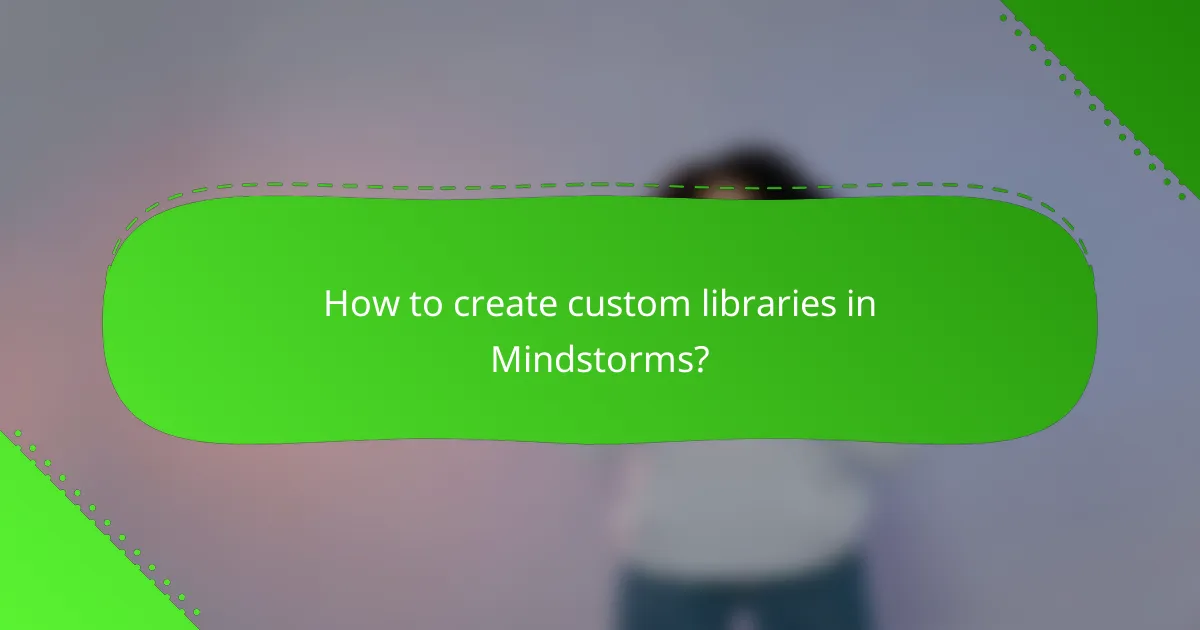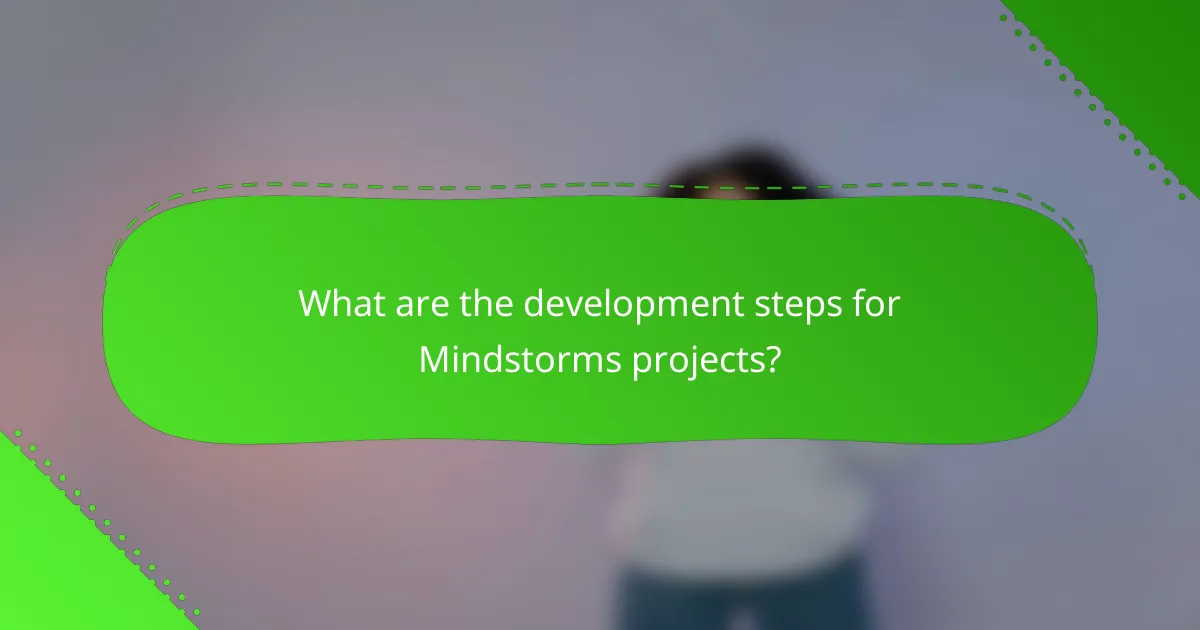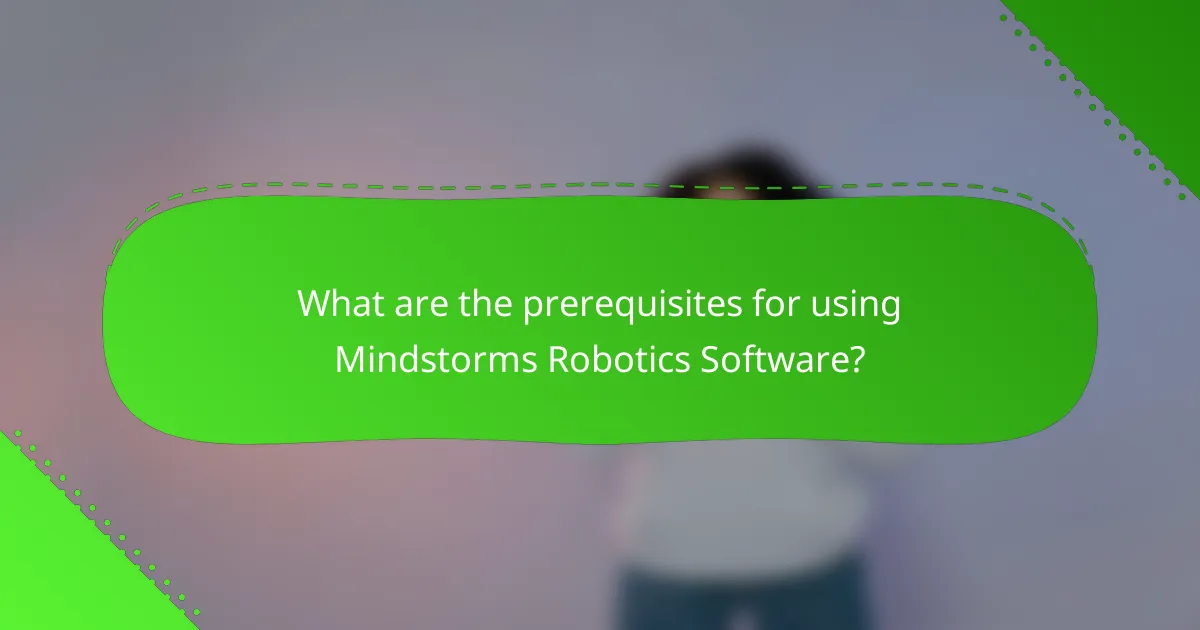Mindstorms Robotics Software provides a comprehensive platform for enhancing robotics development, featuring custom library support and a user-friendly interface. By creating custom libraries, developers can implement tailored functions and classes, significantly improving the reusability of code in their projects. The development process encompasses planning, coding, hardware integration, and deployment, ensuring a successful outcome for robotics initiatives.

What are the key features of Mindstorms Robotics Software?
Mindstorms Robotics Software offers a range of features designed to enhance the robotics development experience. Key functionalities include custom library support, a user-friendly interface, hardware integration, real-time debugging tools, and extensive documentation.
Custom library support
Custom library support allows developers to create and integrate their own libraries into the Mindstorms environment. This flexibility enables the reuse of code and the implementation of specific functionalities tailored to unique projects.
When developing custom libraries, ensure they are compatible with the Mindstorms API. This can streamline your workflow and enhance the capabilities of your robotic applications.
User-friendly interface
The Mindstorms Robotics Software features a user-friendly interface that simplifies programming for users of all skill levels. The drag-and-drop functionality allows for easy assembly of code blocks, making it accessible for beginners while still powerful for advanced users.
To maximize efficiency, familiarize yourself with the layout and available tools. This understanding can significantly reduce the time spent on project setup and execution.
Integration with hardware
Mindstorms software seamlessly integrates with various hardware components, including sensors and motors. This compatibility allows for a wide range of robotic applications, from simple tasks to complex behaviors.
When selecting hardware, ensure that it is supported by the software to avoid compatibility issues. Testing components together early in the development process can help identify potential challenges.
Real-time debugging tools
Real-time debugging tools are essential for identifying and resolving issues during the development of robotic applications. These tools provide immediate feedback on code execution, helping developers pinpoint errors quickly.
Utilize breakpoints and step-through debugging features to analyze code behavior in real time. This approach can significantly reduce troubleshooting time and improve overall project quality.
Extensive documentation
The extensive documentation provided with Mindstorms Robotics Software is a valuable resource for developers. It includes tutorials, API references, and troubleshooting guides, which can help users navigate challenges effectively.
Regularly consult the documentation to stay updated on new features and best practices. Engaging with community forums can also enhance your understanding and provide additional insights from experienced users.

How to create custom libraries in Mindstorms?
Creating custom libraries in Mindstorms involves defining a clear structure, implementing necessary functions and classes, testing for functionality, and deploying the library in your projects. This process enhances the capabilities of your robotics projects by allowing for reusable code tailored to specific tasks.
Define library structure
Start by outlining the structure of your library, which typically includes a main module and any submodules necessary for organization. Consider using a naming convention that reflects the purpose of each component, making it easier to navigate and understand.
For example, you might create a folder named “MyLibrary” containing files like “Movement.py” and “Sensors.py.” This organization helps maintain clarity and simplifies future updates or expansions.
Implement functions and classes
Next, implement the functions and classes that will form the core of your library. Each function should serve a specific purpose, such as controlling motors or reading sensor data, while classes can encapsulate related functionalities.
For instance, a “MotorController” class could include methods for starting, stopping, and adjusting speed. Aim for concise and well-documented code to facilitate ease of use and understanding.
Test library functionality
Testing is crucial to ensure your library works as intended. Create test cases that cover various scenarios, including edge cases, to validate the functionality of each function and class.
Utilize Mindstorms’ built-in testing tools or create simple scripts that invoke your library’s functions to confirm they behave correctly. This step helps identify and rectify any issues before deployment.
Deploy library in projects
Once testing is complete, you can deploy your library in Mindstorms projects. Import your custom library into your project files, ensuring the paths are correctly set up for easy access.
Consider documenting how to use your library within your projects, including example code snippets. This documentation will assist others in understanding and utilizing your library effectively.

What are the development steps for Mindstorms projects?
The development steps for Mindstorms projects typically involve planning, coding, integrating with hardware, and deploying the final product. Each step is crucial for ensuring a successful and functional robotics project.
Project planning and design
Effective project planning and design lay the foundation for a successful Mindstorms project. Start by defining the project goals, target audience, and specific functionalities you want to achieve. Create a flowchart or diagram to visualize the robot’s operations and interactions.
Consider the resources available, including time, budget, and materials. This will help you prioritize features and set realistic milestones throughout the development process.
Code development and testing
During the code development phase, focus on writing modular and reusable code to enhance maintainability. Use the Mindstorms software to create custom libraries that encapsulate common functions, which can simplify your coding tasks.
Testing should be iterative; regularly test each module as you develop it. This approach helps identify bugs early and ensures that each part of the code works as intended before integrating it with other components.
Integration with Mindstorms hardware
Integrating your code with Mindstorms hardware involves connecting sensors, motors, and other components to the programmable brick. Ensure that your code correctly interfaces with the hardware to execute the desired actions.
Pay attention to the power requirements and communication protocols of the devices. Testing the integration in stages can help you troubleshoot issues more effectively, ensuring that both hardware and software function harmoniously.
Final project deployment
The final project deployment stage involves preparing your robot for real-world operation. This includes final testing to confirm that all components work together seamlessly and that the robot performs its intended tasks reliably.
Consider documenting the project thoroughly, including code comments and user manuals, to assist others in understanding and using your robot. Once deployed, gather feedback to identify areas for improvement in future projects.

What are the prerequisites for using Mindstorms Robotics Software?
To effectively use Mindstorms Robotics Software, you need basic programming knowledge, familiarity with robotics concepts, and access to the appropriate Mindstorms hardware. These prerequisites ensure that you can navigate the software and create functional robotic applications.
Basic programming knowledge
A foundational understanding of programming is essential for utilizing Mindstorms Robotics Software. Familiarity with concepts such as variables, loops, and conditionals will help you write and debug code effectively. Languages like Python or Java are often beneficial, as they are commonly used in robotics programming.
Start by learning the basics of a programming language that is compatible with Mindstorms, such as Python. Online courses and tutorials can provide structured learning paths to build your skills.
Familiarity with robotics concepts
Understanding core robotics concepts is crucial for successful software application. This includes knowledge of sensors, actuators, and control systems, which are integral to building and programming robots. Familiarity with concepts like feedback loops and sensor integration will enhance your ability to create responsive robotic systems.
Consider studying basic robotics through online resources or local workshops. Engaging in hands-on projects can also solidify your understanding of how these concepts apply in practice.
Access to Mindstorms hardware
Having access to Mindstorms hardware is necessary for testing and implementing your software projects. This includes the Mindstorms brick, motors, sensors, and building elements. Without the physical components, you cannot fully explore the capabilities of the software.
Investing in a Mindstorms kit, such as the LEGO Mindstorms EV3 or Robot Inventor, provides you with the essential tools to start building and programming. Ensure that you have all necessary components to maximize your learning experience.

How does Mindstorms compare to other robotics software?
Mindstorms stands out among robotics software for its user-friendly interface and robust educational resources. While other platforms may offer advanced features, Mindstorms excels in accessibility for beginners and educational environments.
Ease of Use
Mindstorms is designed with simplicity in mind, making it ideal for newcomers to robotics. Its drag-and-drop programming interface allows users to create complex behaviors without needing extensive coding knowledge. In contrast, many other robotics platforms require familiarity with programming languages, which can be a barrier for beginners.
Educational Focus
Mindstorms is heavily utilized in educational settings, providing structured learning paths and resources tailored for students. This focus on education helps users grasp fundamental concepts of robotics and programming. Other software may lack this educational emphasis, making it less suitable for classroom environments.
Community and Support
The Mindstorms community is vibrant and supportive, offering forums, tutorials, and shared projects. This collaborative environment encourages users to learn from one another and share their experiences. While other robotics software may have communities, they often do not match the level of engagement and resources available for Mindstorms users.
Customization and Flexibility
Mindstorms allows for significant customization through its software, enabling users to create unique programs and integrate various sensors and motors. However, some advanced robotics platforms offer deeper customization options and greater flexibility for professional applications. Users should consider their specific needs when choosing between Mindstorms and more advanced alternatives.
